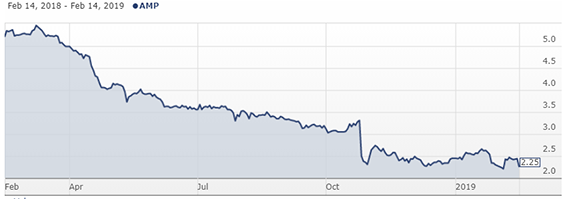More trouble ahead for scandal-plagued AMP, says Morningstar
Beleaguered wealth manager AMP faces a world of Hayne-related pain for years to come, says Morningstar, as customers desert its superannuation funds and the threat of court action mounts.
Mentioned: AMP Ltd (AMP)

- Net profit down 97pc to $28m
- Operating revenue down 55pc to $8.29b
- Final dividend down 10.5 c to 4c, 90pc franked
Beleaguered wealth manager AMP faces a world of Hayne-related pain for years to come, says Morningstar, as customers desert its superannuation funds and the threat of court action mounts.
The 170-year-old wealth manager felt the full impact of the Kenneth Hayne-led royal commission, revealing a 97 per cent drop in full-year statutory profits to a worse-than-expected $28 million on Thursday.
This is down $848 million from a year earlier after it made a total $807 million in provisions, $656 million of which was for customer remediation following scandalous revelations from the year-long Hayne inquiry.
The inquiry heard AMP charged life insurance premiums to dead clients and told regulators that clients were charged ongoing fees because of administrative errors when it was in fact a conscious effort by the company. The revelations led to the exit of chief executive Craig Meller and chairman Catherine Brenner.
AMP’s woes aren’t over yet, says Morningstar equity analyst Chanaka Gunasekera, whose latest research note highlights the millions in customer remediation, weakness in the superannuation business, and billions in cash outflows.
"In order to stem the outflows, AMP will need to recover from the reputational damaged caused by the royal commission, improve its product offering and intensify its sales effort. We don’t believe this is realistic in the next few years," he says.
Instead of increasing AMP’s sales efforts, new chief executive Francesco De Ferrari has indicated his three priorities are separating out the Australian and New Zealand wealth protection and mature businesses, delivering advice remediation, and strengthening risk management internal controls and governance.
Underlying net profit after tax for the company's core Australian wealth management division fell 7.2 per cent to $363 million. Gunasekera now forecasts a more precipitous fall to $175 million in 2019, pointing out that the result only partly accounts for the lower re-pricing of its MySuper product range and other price reductions that occurred during 2018.
"They also do not account for the $85 million loss due to distribution fees and products which are being transferred as part of the sale to Resolution Life or extra compliance cost changes of $15 million," he said.
Gunasekera believes the 97 per cent fall in first-half profit also reflects a trend of investors moving from retail superannuation funds like AMP to industry funds and doesn't believe the wealth manager will be able to stem the outflows in the near future.
AMP’s retail super platforms reported net cash outflows of $1.715 billion in 2018, with fund outflows accelerating from already elevated levels in the fourth quarter.
Gunasekera now forecasts outflows from its retail super platforms from 1.9 per cent of funds under management in 2018, to 1.7 per cent outflow in 2019 before stabilising to 1 per cent growth from 2022.
Price Chart | AMP (ASX: AMP)

De Ferrari, who took over as chief executive in December, said he believed the public still harboured "goodwill toward the AMP brand" and that the company could regain consumer trust.
"The royal commission has been a confronting but valuable experience for the financial services industry and has served as a catalyst for change at AMP," De Ferrari said.
"We have undertaken board and leadership renewal, accelerated client remediation and sharpened our focus on delivering better value to customers."
AMP shares fell 7.79 per cent on Thursday as the company cut its dividend 10.5 cents to 4 cents. It has since risen. At midday on Friday, it was trading at $2.20.
Reputational damage was the primary reason AMP gave when explaining why customers had pulled $4 billion from its wealth management division in 2018.
Gunasekera says AMP Bank and AMP Capital delivered reasonable results in 2018, growing 5.7 per cent and 7.1 per cent respectively.
AMP Bank was helped by residential mortgage book growth and AMP Capital continued to benefit from strong fund inflows from sources external to AMP’s business. However, he expects AMP Bank to endure a fall in earnings in 2019, due the disruptions to its key mortgage broker distributional channel and increased compliance costs brought on by the royal commission. Tighter lending standards will also weigh on earnings in 2019.
Gunasekera expects AMP Capital to continue to be a driver of earnings growth.
Reputational damage aside, Gunasekera says AMP dodged a bullet with Hayne's decision to leave their vertically integrated wealth management business model largely intact.
"[This was a] key risk to its inherent value that has been avoided," he said. "Our base case assumed this would be the commissioner’s ultimate decision and so this decision does not impact AMP’s fair value estimate."
Gunasekera remains concerned that the Hayne final report raises several issues for AMP that are likely to keep its misconduct in the public eye, hurt fund flows and financial advisers to its business for several years, and raise the prospect of court action.
"In addition to the high likelihood that ASIC will take future court action against AMP, there is also a high likelihood it will also add further conditions to AMP’s licence as well as embedding officers within AMP.
"The final report provides a smorgasbord of evidence for the class action lawyers circling it, as well as regulators for breaches of civil law."

